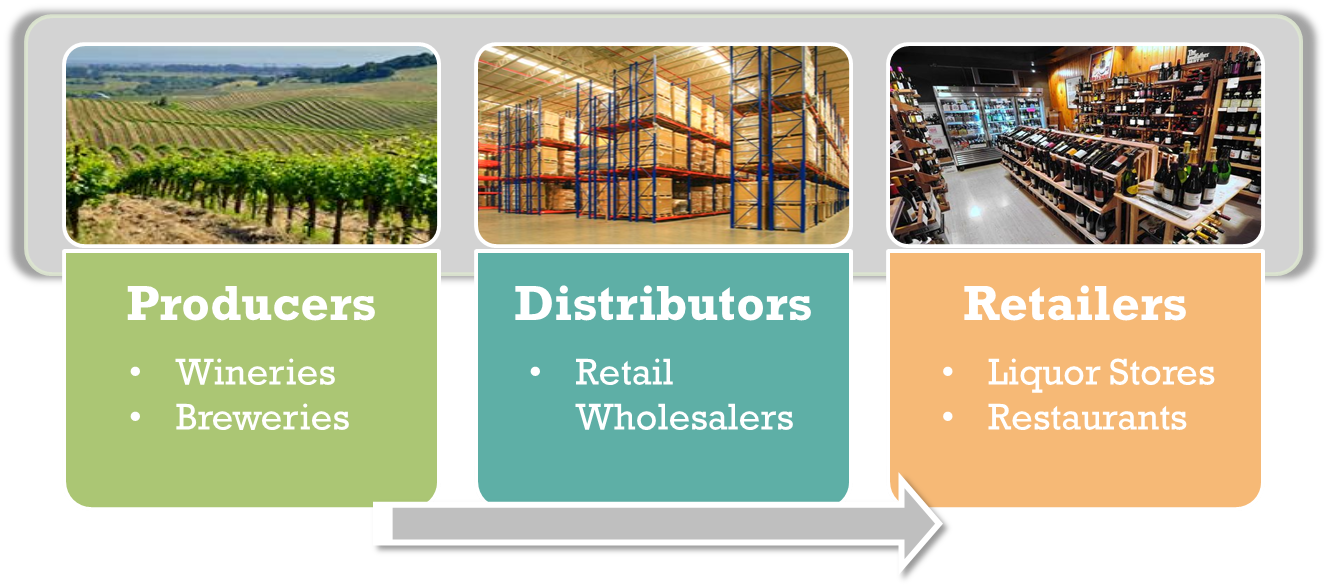 The three-tier distribution system (Maker – Distributor – Retailer) goes back to the repeal of Prohibition in the United States in 1933. The states were put in charge of the laws around distribution of alcohol, but the states and the federal governmentwere mostly concerned about collecting taxes. Most states have outlawed the ownership of the entire chain of distribution to make sure there are clear demarcation points where they can collect, except in some special cases like brewpubs.
The three-tier distribution system (Maker – Distributor – Retailer) goes back to the repeal of Prohibition in the United States in 1933. The states were put in charge of the laws around distribution of alcohol, but the states and the federal governmentwere mostly concerned about collecting taxes. Most states have outlawed the ownership of the entire chain of distribution to make sure there are clear demarcation points where they can collect, except in some special cases like brewpubs.
Winery or Importer – The production of the product happens here and ends with the cases of wine being placed on a loading dock, at which point the ownership changes to the distributor. The wine is sold quite inexpensively (compared to a wine list price) to the distributors with typical gross margins for a higher end winery being around 50-60% over costs, according to Silicon Valley Bank. Wineries love to have people come to the estate and buy wine directly, because they make the profit of the entire distribution chain.
Importers are like wineries from the point of view of distribution. They are usually identifying great wines outside the United States and taking the risk to import that wine. They will commit to container loads of wine with the view of selling them to distribution. Most specialize in a particular area of the world, perhaps Italy or Australia or Chile. The gross margins of a typical importer are around 30%.
Distributor – Because the liquor laws vary by state, the distributors are state by state as well, including some counties that take the role of the distributor and take not only the taxes on the wine, but the margin of the distributor. The distributors will commit to producers and importers to take their wine and sell it to restaurants and retailers in their served areas. This means skilled sales people with deep wine knowledge and the willingness to provide samples and tasting as part of the sales process. They are also on the hook if a bottle is corked and the retailer returns the bottle and hold a significant amount if inventory in a temperature controlled warehouse. Typical distributor gross margins are around 30% for the distributor.
Retailer – The bottle finally arrives at the retailer, ready for you to purchase. The retailer has the physical location for your purchase, although over time wine laws are being rationalized and internet marketers are coming into play like most markets. They hold inventory, have trained staff, light, insure and maintain temperature for their inventory until you purchase. Typical gross margins are a little higher here, at 40%, but costs are higher too. There are a few mega-retailers that buy massive quantities at excellent prices and operate on somewhat lower margins like Total Wine and Costco.
Restaurant – If your wine doesn’t go to a retailer, it might go to a restaurant and appear on the wine list. This is the most expensive place to purchase a bottle of wine, but it’s a great place to try something new. The normal rule of thumb for a restaurant is triple their purchase price to set the wine list price. If they buy it for $30, it might be $90 on the wine list, or a 66% gross margin, although some restaurants are little more moderate with their mark-ups. This is designed to cover the staff, storage, training, glassware and a decent profit. In a prior article, I discussed how the wine program can be the reason a great restaurant is profitable. If the bottle is sold by the glass, perhaps at the bar, the rule of thumb is that the glass costs what the bottle does. This assumes 6 healthy pours per bottle.
Adding it Up
Let’s take a bottle of wine that appears on a wine list at $100 and see what everyone in the chain received. The distributor sold that bottle to the restaurant for around $35. They purchased the wine from the winery at around $25 and the cost to product the bottle would be $12-15. Yeah, it seems expensive, but the perfect bottle of wine at the right moment, can’t be beat.
Cheers!

